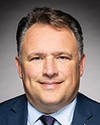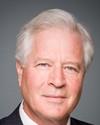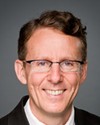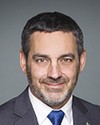Good afternoon, honourable committee members. Thank you for having me here today.
If you flip to the second slide, that is a picture of me. That's a 12-year-old soccer player, my first organized soccer experience. This was a house league in Mississauga. This little guy ended up moving on to play professionally in Canada and the United States, as well as playing for our province, and for our country one time, which I consider a great honour. But the fact is that all of this was quite a fluke. It was really by accident. There is no grand design within the structure in Canada, —although we're moving towards it right no, that actually will guarantee success for budding athletes.
Oakville Soccer Club started about 40 years ago in the garage of some well-meaning volunteers and we've grown to about 12,000 participants. Eleven thousand of them are house league or recreational players, and 1,000, or just under 1,000, are rep players. Within that rep group probably only 200 or so of them we consider to be part of that high-performance track.
We plan for success by implementing a five-year strategic plan that we started in 2011. That plan is hinged upon the principles of long-term player development, which are tied in with long-term athletic development, which is supported by Sport Canada. We believe that coaching plays a pivotal role to our success and to our meeting all of the elements of our strategic plan. Within our club we have three current players who are in the national men's player pool. We have a little player by the name of Diana Matheson, who scored a goal that won a bronze medal for Canada at the recent Olympics. Kara Lang is a former captain of our national team, and she is another Oakville resident. We also have a number of players in current youth systems at various levels in Canada and in international youth national teams.
On the next slide if you look at Canadian participation rates, we have a very broad base of players, about 867,000 registered Canadian soccer players. Canada ranks 10th in the world. For registered and unregistered players, we rank 22nd, which is only two spots and probably about 100,000 players fewer than the predominant world power in soccer right now, Spain.
At the club level we're starting to see a plateau in registration, or a mild contraction. We think that is partially due to a lack of quality coaching, lack of resources, as well as competition from other sports and from within the sport.
What we see as a difference between here and Spain is that Spain has a large professional and national infrastructure that drives player development and coaching development at a very high level. It shows excellence at a higher level, and that pulls along everybody else. They have over 23,000 UEFA B, A, and Pro licence coaches, which are the equivalent of the Canadian National B and A licence coaches. We have about 553 of those across the country.
It's important to make a distinction between community and high performance. Recreational soccer is very different, but they're intertwined. Community soccer is low priced. It's about fun, enjoyment of the game, and celebration of the game. You can play from cradle to grave. We have four-year-olds who play, and we have 55- and 60-year-olds who play in our club. This still requires investment on the part of our club, but the heavier investment is on the high-performance side. It's a very heavy price tag. It's intense, and a very small fraction of our players use a lot of allocated resources. There's about a 20-year window where we really spend a lot of money on these athletes. What we find in soccer, and I think it's true for Canadian sport in general, is there's a blurred line between high performance and community participation. We want everyone to participate, and you can't treat everyone equally when you're looking at those two streams.
Further into community and high performance, I will say that they're definitely interconnected. Every single high-performance athlete starts off as a recreational athlete and then later becomes a recreational athlete again sometime in their life. As I said, right now because the lines are blurred between the two within soccer, what we find is neither group is actually served particularly well.
At Oakville Soccer Club we have now invested in coaches. We have over 800 coaches within our club alone. We have 750 of them who are volunteers. The circled areas on the sheet are where we've invested heavily. In the red area we have 28 age group head coaches. They are part-time paid professional coaches. As well, we have four full-time coaches: me, two staff coaches, and a coach development manager.
Once again, we've invested heavily in coaching development and increasing our coaching resources. Also, we invest or subsidize all the licensing for all the players, all the coaches within our club.
The reason we invest heavily in U8 to U12, which is really where we put a lot of our resources, is that's the largest pool of players with the potential to go to the excellence stream. We also believe that those athletes who have better skill development from U8 to U12 will stay in the sport longer and, once again, add to the overall soccer community in the soccer for life phase down the road.
At this point we're focusing on skill development, based on the long-term player development, LTPD, plan. We don't concentrate on teams as much as we concentrate on the individual.
The next slide is on the Canadian coaching streams. All of our coaches are also registered with the NCCP. We have a community stream and a high-performance stream. The community stream is managed by the province, the provincial association, and it costs about $250 to $500 for each of the levels within that course. They also have to take the making ethical decisions course and the respect in soccer course, which also cost money. In order to move on to the competitive stream, either you need to have a national or a professional playing background or you have to take the soccer for life course.
When you go to the excellence stream, the first two levels, the provincial B licence and the B licence pre-tests, are run by the provincial association. The A licence and the national B licence are run by the national association. These courses cost between $900 and $1,200, and that doesn't include the travel costs. At Oakville Soccer Club we subsidize these courses for every one of our 800 coaches.
If you go to the next slide, the structure is the message. As Marshall McLuhan said, the medium is the message. We firmly believe that the structure is the message. If we build the structure properly, it will make sure we're making educated choices at the club level in terms of how we allocate our resources.
We have an inverse power relationship within soccer in Canada. The Canadian Soccer Association wields very little power. The power is really diffused between the provinces and even further down between the clubs that make up the large 867,000 base of players. The way to help that is, obviously, economic power, but even more so, organizational and expertise power. Having that at the CSA level we would be able to pull a lot more interest and passion for the game and be an example of excellence so that our coaches can follow that.
We also think that long-term player development and following those guidelines are crucial to the development of the game in this country, and that there needs to be a distinction between that excellence stream and that recreational stream. Each needs to be funded accordingly.
On the next one, follow the money, we have an annual budget of $7.5 million at the Oakville Soccer Club. The CSA, the Canadian Soccer Association, has an annual budget of $12 million. The fact that these are so close, we think, is problematic. We also, at the Oakville Soccer Club, spend 10% of our money on coaching development, so about $750,000 a year on either developing coaches or paying coaches.
On the next one, you will see we have an excellent base, a lot of players, and that's fantastic. But in most other countries, if they have a large base like that, a lot of the coaching development is funded by a robust professional and national network. If you look at Spain and England, they have literally 40 to 50 teams that are driving player and coach development, and are examples of excellence within the community.
What we do know in Canada is that the aggregate investment power of all the clubs together can far outweigh what the provincial associations and the national associations can invest. Once again, we believe that proper structure will help make intelligent resource allocations for those clubs.
On the next slide, when we're looking at creating coaches, we see it as a push and a pull.
The push is at grassroots level. That means we have to continue to drive the structural change that we're driving at the provincial level here in Ontario, where we're making a high-performance standards-based league. We think that will help allocate proper funds to the right channels. We have to differentiate between high performance and recreational tracks. We have to fully support long-term player development as well as strategic planning for all clubs. If you're not planning, you're going to throw good money after bad, and that's a wasted use of resources.
When we look at the pull, it has to be aspirational. We think there really has to be a revamping and a focus on coaching development across the country. We believe that the CSA and the provincial associations need to be pinnacles of excellence. They need to show examples of excellence, because in the aspirational sense, you aspire to be like the best in the industry.
We believe that we need to invest domestically in coaching and administrative and organizational talent, as well as recruit internationally if necessary. We also believe that in the pull part we need to support and drive the professional game here in Canada.
On our final slide is the picture we had at our club of Diana Matheson greeting and meeting one of our five-year-old house league players. Although we don't all make it to excellence within this country, when we do achieve excellence, we all share in it, so we call these people heroes, and we hope to be able to supply and support both tracks within our club.
Thank you very much.







